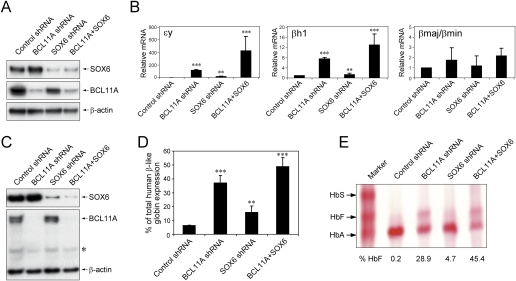Figure 6.
BCL11A cooperates with SOX6 in silencing γ-globin gene expression. (A) Lentivirus-mediated shRNA delivery to MEL cells results in robust knockdown of both BCL11A and SOX6 proteins. Control samples were transduced with lentivirus prepared from the shRNA empty vector. Cells were harvested 4 d after transduction and analyzed by Western blot using antibodies for SOX6 and BCL11A. β-Actin was analyzed as a loading control. (B) shRNA-mediated knockdown of BCL11A and SOX6 results in elevations of ɛy-globin and βh1-globin mRNA levels. P < 0.001 (***) and P < 0.01 (**) in comparison with controls. (C) Lentiviral shRNA in human erythroid progenitors results in robust knockdown of both BCL11A and SOX6 proteins. Control samples were transduced with lentivirus prepared from the empty vector. Cells were harvested 7 d after transduction, which usually corresponded to day 5 in differentiation medium. Whole-cell lysates were prepared and analyzed by Western blot using antibodies for SOX6 and BCL11A. β-Actin was analyzed as a loading control. An asterisk (*) indicates nonspecific bands. (D) shRNA-mediated knockdown of BCL11A and SOX6 results in elevations of γ-globin mRNA levels (as a percentage of total β-like globin gene expression) on day 5 of differentiation. P < 0.001 (***) and P < 0.01 (**) in comparison with controls. (E) Hemolysates prepared from cells on day 14 of differentiation (terminal stage erythroblasts) show the presence of mature HbF. This was assessed using cellulose acetate hemoglobin electrophoresis with a size marker indicating the positions of HbA and HbF. The percentages indicating the proportion of hemoglobin species were determined by measurement from densitometry. All results are means ± SD from three independent experiments. Statistical significance was calculated using a Student t-test.

